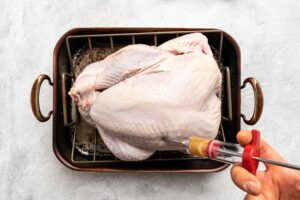Yes, you can thaw and refreeze shrimp, but it depends on how you do it. Proper handling is crucial to ensure safety and maintain quality.
Thawing and refreezing shrimp is a common concern. Many people worry about food safety and taste. Shrimp is a delicate seafood, and improper handling can lead to spoilage or foodborne illness. Understanding the correct methods to thaw and refreeze shrimp will help keep it safe to eat and delicious.
In this blog, we’ll explore the best practices for handling shrimp. We’ll also address common myths and provide practical tips. Knowing these guidelines will ensure your shrimp stays fresh and tasty, even after multiple thawing and refreezing cycles. Let’s dive into the details!
Thawing Shrimp Safely
Thawing shrimp properly is crucial to maintain its quality and safety. Incorrect thawing can lead to bacterial growth. This can make shrimp unsafe to eat. Here are two safe methods to thaw shrimp: the refrigerator method and the cold water method.
Refrigerator Method
The refrigerator method is the safest way to thaw shrimp. It requires planning but ensures the shrimp remains at a safe temperature.
- Place the shrimp in a bowl or on a plate.
- Cover it to prevent contamination.
- Put the bowl or plate in the refrigerator.
- Allow it to thaw for 12-24 hours.
Once thawed, cook the shrimp within one to two days. This method keeps the shrimp at a consistent, safe temperature.
Cold Water Method
The cold water method is faster than the refrigerator method. It requires more attention, but it is still safe if done correctly.
- Place the shrimp in a sealed plastic bag.
- Fill a large bowl with cold water.
- Submerge the bag in the bowl.
- Change the water every 30 minutes.
- Continue until the shrimp is thawed, usually within an hour.
Once thawed, cook the shrimp immediately. Avoid leaving the shrimp at room temperature for too long.

Credit: www.wikihow.life
Risks Of Improper Thawing
Improper thawing of shrimp poses several risks that can affect both health and quality. Understanding these risks is essential to ensure that the shrimp remains safe to eat and maintains its best texture.
Bacterial Growth
One of the main risks of improper thawing is bacterial growth. Thawing shrimp at room temperature allows bacteria to multiply rapidly. This increases the chance of foodborne illnesses. The safest way to thaw shrimp is in the refrigerator. This keeps the temperature low and reduces bacterial growth.
Texture Changes
Improper thawing can also lead to significant texture changes in shrimp. If you thaw shrimp too quickly, it can become mushy. This is often due to the breakdown of its structure. Slow thawing in the fridge helps maintain the shrimp’s firm texture. Refreezing improperly thawed shrimp can also worsen texture issues. The shrimp may become rubbery and less enjoyable to eat.
Refreezing Thawed Shrimp
Thawing and refreezing shrimp can be a tricky process. It is crucial to know when it is safe and how it can affect the quality. Let’s dive into the details of refreezing thawed shrimp.
When It’s Safe
Refreezing thawed shrimp is safe under certain conditions. If the shrimp was thawed in the refrigerator, you can refreeze it within 1-2 days. Ensure the shrimp has not stayed at room temperature for over two hours. Bacteria grow rapidly at temperatures between 40°F and 140°F. Always check the smell and appearance before refreezing. Fresh shrimp should not have an off smell or slimy texture.
Potential Quality Loss
Refreezing thawed shrimp can lead to quality loss. The texture may become mushy, and the flavor may diminish. The process of freezing, thawing, and refreezing affects the shrimp’s cell structure. This results in a less desirable texture. To minimize quality loss, try to use thawed shrimp immediately. If you must refreeze, consider using the shrimp in dishes where texture is less critical. For example, soups, stews, or casseroles.
| Factor | Effect on Shrimp |
|---|---|
| Texture | May become mushy |
| Flavor | Could diminish |
| Appearance | Possible discoloration |
In summary, knowing when it is safe to refreeze thawed shrimp and understanding potential quality loss can help you make informed decisions. Always prioritize safety and quality for the best culinary experience.

Credit: www.theprimal.com
Signs Shrimp Has Gone Bad
Identifying signs that shrimp has gone bad is crucial for food safety. Consuming spoiled shrimp can lead to food poisoning. Pay attention to these clear indicators to avoid any health risks.
Off Smell
Fresh shrimp should have a mild, ocean-like scent. Bad shrimp emits a strong, unpleasant odor. This smell is often described as sour or ammonia-like. If you detect any off smell, discard the shrimp immediately. Trust your nose; it is a reliable guide.
Discoloration
Inspect the color of your shrimp. Fresh shrimp typically has a translucent, pinkish appearance. Spoiled shrimp may turn dull or have dark spots. Black or green patches are also signs of spoilage. Additionally, white spots can indicate freezer burn. This affects the texture and taste.
| Signs | Indications |
|---|---|
| Off Smell | Sour or ammonia-like odor |
| Discoloration | Dark spots, black, green patches, or white spots |
Keep these signs in mind to ensure your shrimp is safe to eat. Regular checks can prevent foodborne illnesses.
Best Practices For Refreezing
Thawing and refreezing shrimp can be tricky. To ensure safety and quality, follow these best practices. Proper storage and labeling are key steps. Let’s dive into the details.
Proper Storage
Proper storage is crucial for refreezing shrimp. Always use airtight containers or freezer bags. This prevents freezer burn and contamination. Make sure to remove as much air as possible from the bags.
Store the shrimp in the coldest part of your freezer. This keeps the shrimp at a consistent temperature. Avoid opening the freezer frequently to maintain the temperature.
Labeling
Labeling your shrimp is another important step. Write the date of refreezing on the container. This helps you keep track of how long the shrimp has been in the freezer.
Also, include any other important information. For example, write down if the shrimp was previously cooked or raw. This helps you remember the shrimp’s condition when you thaw it again.
Cooking Shrimp After Thawing
Cooking shrimp after thawing can be a bit tricky. Proper handling ensures the best taste and safety. Let’s explore the right ways to handle shrimp after thawing.
Immediate Use
If you plan to use the shrimp right away, follow these steps:
- Thaw shrimp in the refrigerator overnight.
- Rinse under cold water to remove ice crystals.
- Pat dry with a paper towel.
- Cook immediately to preserve texture and flavor.
Cooking methods include boiling, grilling, or sautéing. Cooking times are short, usually around 3-5 minutes. Ensure shrimp turns pink and opaque.
Refrigerated Storage
If you can’t cook the shrimp immediately, store them properly:
- Place thawed shrimp in an airtight container.
- Store in the coldest part of the refrigerator.
- Use within 1-2 days for best quality.
Check the shrimp for any off-smell before cooking. If it smells bad, discard it. Ensuring proper storage preserves freshness and prevents foodborne illnesses.
Alternatives To Refreezing
Refreezing shrimp can impact its texture and flavor. Thus, exploring alternatives is crucial. Here are some effective methods to keep your shrimp fresh without refreezing.
Cooking And Storing
Cooking shrimp immediately after thawing is a great option. It preserves the texture and taste. Once cooked, you can store the shrimp in the refrigerator for up to three days.
Here are some methods to store cooked shrimp:
- Place in an airtight container
- Wrap tightly in aluminum foil or plastic wrap
- Use vacuum-sealed bags for longer freshness
Another handy tip: Always label your storage containers with the date. This ensures you use the shrimp while it’s still fresh.
Using In Recipes
Thawed shrimp can be used in many recipes. This helps avoid the need to refreeze. Consider these options:
- Shrimp salad – Mix with greens, avocado, and a light dressing
- Shrimp pasta – Add to your favorite pasta with garlic and olive oil
- Shrimp tacos – Combine with fresh veggies and tortillas
Using shrimp in various dishes not only saves it from refreezing but also adds variety to your meals.
For those who meal prep, cooked shrimp can be a versatile ingredient. You can add it to rice bowls, stir-fries, or soups.
Cooking the shrimp after thawing it and incorporating it into different recipes is a smart way to maintain freshness and enjoy delicious meals.

Credit: www.greedygourmet.com
Expert Tips
Freezing and thawing shrimp can be tricky. To help, here are some expert tips. These tips ensure your shrimp stays safe and tasty. Follow these steps to avoid common pitfalls.
Avoiding Cross Contamination
Cross contamination is a risk with seafood. Always handle shrimp with care. Use separate utensils for raw and cooked shrimp. Clean surfaces and tools after use. Wash your hands before and after handling shrimp. This reduces the risk of bacteria spreading.
Store raw shrimp in sealed containers. Keep them away from other foods. This prevents juices from leaking. It also keeps your fridge clean and safe.
Maintaining Freshness
To keep shrimp fresh, thaw it properly. Always thaw shrimp in the fridge. Do not thaw it at room temperature. This slows bacterial growth. Place shrimp in a bowl or on a plate to catch any liquid.
If you need to thaw shrimp quickly, use cold water. Put the shrimp in a sealed plastic bag. Submerge the bag in cold water. Change the water every 30 minutes. Do not use hot water. It can start to cook the shrimp.
After thawing, cook shrimp within two days. Do not refreeze thawed shrimp. Refreezing can affect texture and taste. It can also increase the risk of foodborne illnesses.
| Steps | Details |
|---|---|
| Thawing in Fridge | Slow, safe method. Takes several hours. |
| Thawing in Cold Water | Faster method. Takes 30-60 minutes. |
| Do Not Thaw at Room Temp | Unsafe. Increases risk of bacteria. |
Frequently Asked Questions
Can You Refreeze Thawed Shrimp?
Yes, you can refreeze thawed shrimp. Ensure it’s been thawed in the fridge. Refreeze it within 24 hours.
Is It Safe To Refreeze Shrimp?
Yes, it’s safe to refreeze shrimp if thawed properly. Always use the refrigerator for thawing.
How Many Times Can You Refreeze Shrimp?
It’s best to refreeze shrimp only once. Multiple refreezing can affect texture and taste.
What Happens If You Refreeze Shrimp?
Refreezing shrimp can cause texture changes. It may become mushy. Ensure proper thawing for best quality.
Conclusion
Thawing and refreezing shrimp can be safe if done properly. Always thaw shrimp in the fridge. Never leave it out at room temperature. Once thawed, cook shrimp promptly. If needed, refreeze cooked shrimp for future use. This helps maintain taste and texture.
Proper handling ensures food safety and quality. Remember, a little care goes a long way. Enjoy your shrimp dishes with peace of mind. Follow these tips for safe and delicious meals. Happy cooking!
Keep exploring our blogs for expert tips, tasty recipes, and everything you need to make your culinary adventures unforgettable. Stay with Brisket Town for all the latest food insights, delicious finds, and much more. Happy cooking!



